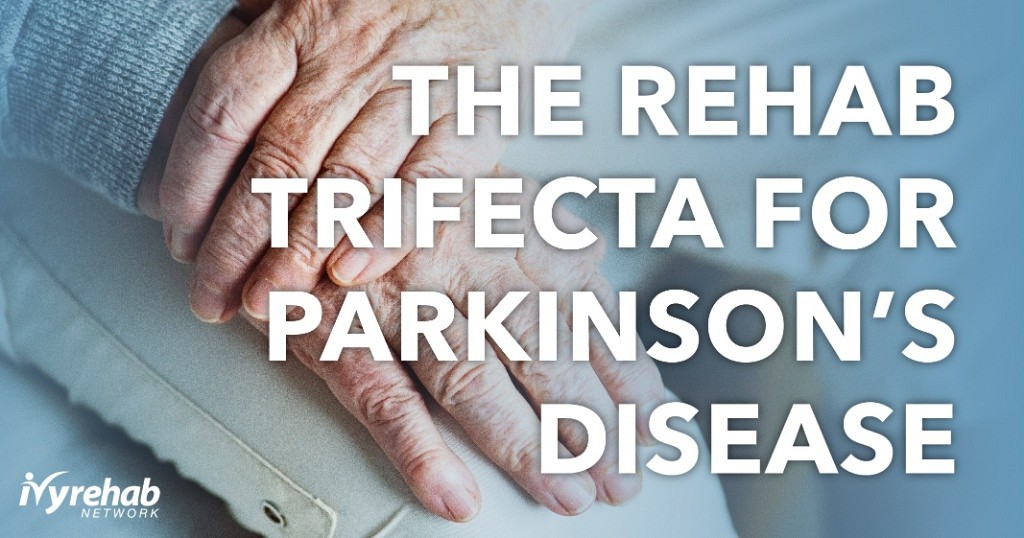When it comes to staving off Parkinson’s disease’s progression, movement is the best medicine. A long-term degenerative disease that affects mobility, speech and motor skills, Parkinson’s is the fastest-growing neurologic disorder worldwide and set to outpace dementia. Parkinson’s disease afflicts 1 million people in the United States and 6.9 million people globally. That figure is projected to reach pandemic status and double to 14.2 million people by 2040. Many people think tremors are a hallmark of the disease, but the earliest detectable sign is a change in or loss of sense of smell, according to Brian J. Keenoy, PT, DPT. “A decreased sense of smell or a loss of smell is detectable six years before there is any sort of movement symptoms,” he said.
Keenoy serves as Director of Outpatient Services for Ivy Rehab Network’s Generation Care clinics in Grand Haven and Muskegon, Michigan. He also has an LSVT BIG certification, which is a specific treatment approach to combat the movement issues related to Parkinson’s Disease. “Parkinson’s disease is the second most debilitating neurologic disorder after dementia in the United States,” he said.
Importance of Early Detection of Parkinson’s Disease
The good news is the earlier Parkinson’s is detected, the better chance patients have of managing it. Currently, there is no cure.
“Research has shown the sooner you attack the Parkinson’s, the better off you are in terms of long-term mobility,” Keenoy said. “A lot of people wait too long, two or three years before they go to their doctor; that is two or three years that you could have been proactively combatting your Parkinson’s symptoms.”
The Trifecta of Care: Physical, Occupational and Speech Therapy for Parkinson’s
Due to West Michigan’s robust Parkinson’s population, Generation Care offers a multidisciplinary approach to care. Patients can participate in physical therapy, occupational therapy, speech therapy, an aquatic exercise class, a land-based exercise class or attend a monthly support group.
Keenoy has specialized in the treatment of people with Parkinson’s disease for nearly five years, getting to work with nearly 100 individuals. The patients he works with are hard-working and motivated, and they realize the benefits of staying active and proactive to maintain their mobility.
“They are such a rewarding population to work with,” he said. “They work so hard and they want to control what they can. We get to move, we get to be silly. It’s a fun environment in the clinic to get to work with patients with Parkinson’s.”
Early Signs and Symptoms of Parkinson’s Disease
Age and genetics, especially for early-onset Parkinson’s, do play a role in Parkinson’s disease, but a growing body of research shows environmental factors may be a bigger cause for concern. This includes chemical exposure, geographic region, and living in rural versus urban areas, Keenoy said. Parkinson’s usually presents between 50 and 65 years old, but early-onset can start in a person’s 40s.
“The closer you are to the source, the greater the likelihood you are to get it,” he said of the chemical exposure. “Vietnam vets have Parkinson’s at an alarmingly higher rate, they think due to Agent Orange.”
The pathophysiology of Parkinson’s disease involves the failure of certain brain cells’ “garbage removal” system. This leads to the death of cells that create dopamine in the brain. Dopamine helps with smooth, purposeful movements. It is a crucial neurotransmitter for movement, emotions, and sensations of pleasure.
Getting a Diagnosis
As Parkinson’s progresses, the brain slowly loses dopamine supplies. There are no visible signs until someone has 70 to 80 percent of dopamine loss. That is why it can be tricky to diagnose. Parkinson’s is not detectable by an MRI, body scan or blood test. In addition, 40 percent of people with Parkinson’s disease don’t see a neurologist.
“It’s a clinical diagnosis,” Keenoy said, which is why talking to your physician early about any concerns with mobility is important. “It’s very much a gray medical area with no conclusive tests. However, there are some really good movement disorder specialists that are very good at picking up on the nuances of Parkinson’s.”
The diagnosis comes down to various signs and symptoms related to motor function, including slow movement, small movement, rigidity, tremors, postural instability, or freezing of gait. On the non-motor side, signs may include mood disorders, low blood pressure, cognitive changes, sleep difficulties, loss of sense of smell, pain, fatigue and impulse control disorders.
People often report losing their balance, tripping more, or having difficulty picking their feet up to walk. They may struggle to write, button a shirt, or get in and out of the car. For example, a 72-year-old who golfs regularly and suddenly struggles to get out of a chair should talk to their doctor.
“Things that weren’t difficult, all of a sudden they are kind of difficult to do,” Keenoy said. “Their decline is more rapid and not age-appropriate.”
How Physical Therapy Can Help Parkinson’s Disease
After a Parkinson’s diagnosis, there are pharmaceutical and surgical options to help increase dopamine production. Patients also benefit from physical, speech and occupational therapies, and high-intensity exercise, which can stave off Parkinson’s progression. A physician’s referral is not needed to start PT, and an evaluation looks at strength, balance, range of motion, gait, and functional mobility. It establishes where you are at currently, how PT can help get you to where you want to go, and if you are safe for exercise.
Keenoy’s passion has become educating patients on the benefits of physical activity and motivating them to find an activity they will continue. Exercise increases dopamine production along with other “feel good” chemicals, promotes neuroplastic changes of the brain and is vital in maintaining mobility.
“Exercise is the best medicine because it can enhance your brain’s ability to create this neurotransmitter,” he said. “It makes the brain more efficient; you can utilize it more effectively.”
LSVT Programs for Parkinson’s Disease
LSVT BIG and LSVT LOUD are the most researched and proven treatment methods. LSVT BIG is an exercise approach specific to combating the motor impairment of Parkinson’s disease and focuses on amplitude, or bigness, and high-intensity exercise.
“The things that have been proven most effective are large exaggerated movements, cycling, boxing, tai chi, dancing,” he said. “A lot of people have never been a regular exerciser so I say ‘find something you like or something you don’t hate and do that.’”
LSVT treatment protocol calls for 16 one-hour treatment sessions, four times per week for four weeks. That is not always feasible so Keenoy says to start with 10 to 15 minutes of daily exercise. Some patients show improvement with one to four sessions per week, ranging from four to 12 weeks. After that, Keenoy typically meets with patients a couple of times a year to assess their fall risk and see how things are going.
Keenoy also focuses on teaching people how to apply the treatment principals to getting out of a chair, putting on their shoes, or other functional and recreational activities. “My job is to give them the right tools and tell them why we are doing what we are doing,” he said. “For a scary diagnosis, there are a lot of things they can do to stay at the level they are currently at or stave off the progression of Parkinson’s Disease.”
Beyond Physical Therapy for PD
Speech therapy and LSVT LOUD can help patients maintain their voice quality, volume and address any swallowing difficulties, as well as breathing exercises to help enhance voice volume. Occupational therapy helps with daily living tasks such as dressing, eating, and driving. Along with PT, having the support of your caregiver and medical team, finding a good neurologist, and learning all you can about the disease can make all the difference in living with Parkinson’s disease. That is also why Generation Care offers a monthly support group meeting to share tips, education, and hope.
“Going to a rehab specialist, they will give you the right tools to manage your Parkinson’s for a lifetime,” he said. “It’s a lifetime diagnosis, every day you are trying to combat the issues of Parkinson’s.”
If you have recently been diagnosed with Parkinson’s Disease, or are worried it has been undiagnosed, contact your nearest Ivy Rehab Network clinic for an evaluation. Ivy’s friendly and skilled therapists offer a variety of therapy options to help Parkinson’s patients manage the disease and continue their favorite activities.
Article Reviewed by Holly Lookabaugh-Deur, PT, DSc, GCS, CEEAA
Holly Lookabaugh-Deur, PT, DSc, GCS, CEEAA is a practicing physical therapist and a partner and Director of Clinical Services at Ivy Rehab Network. Deur is board certified as a geriatric clinical specialist and certified exercise expert for aging adults with more than 35 years of clinical experience. She is certified as an aquatic and oncology rehabilitation specialist and serves as adjunct faculty at Central Michigan University and Grand Valley State University.







